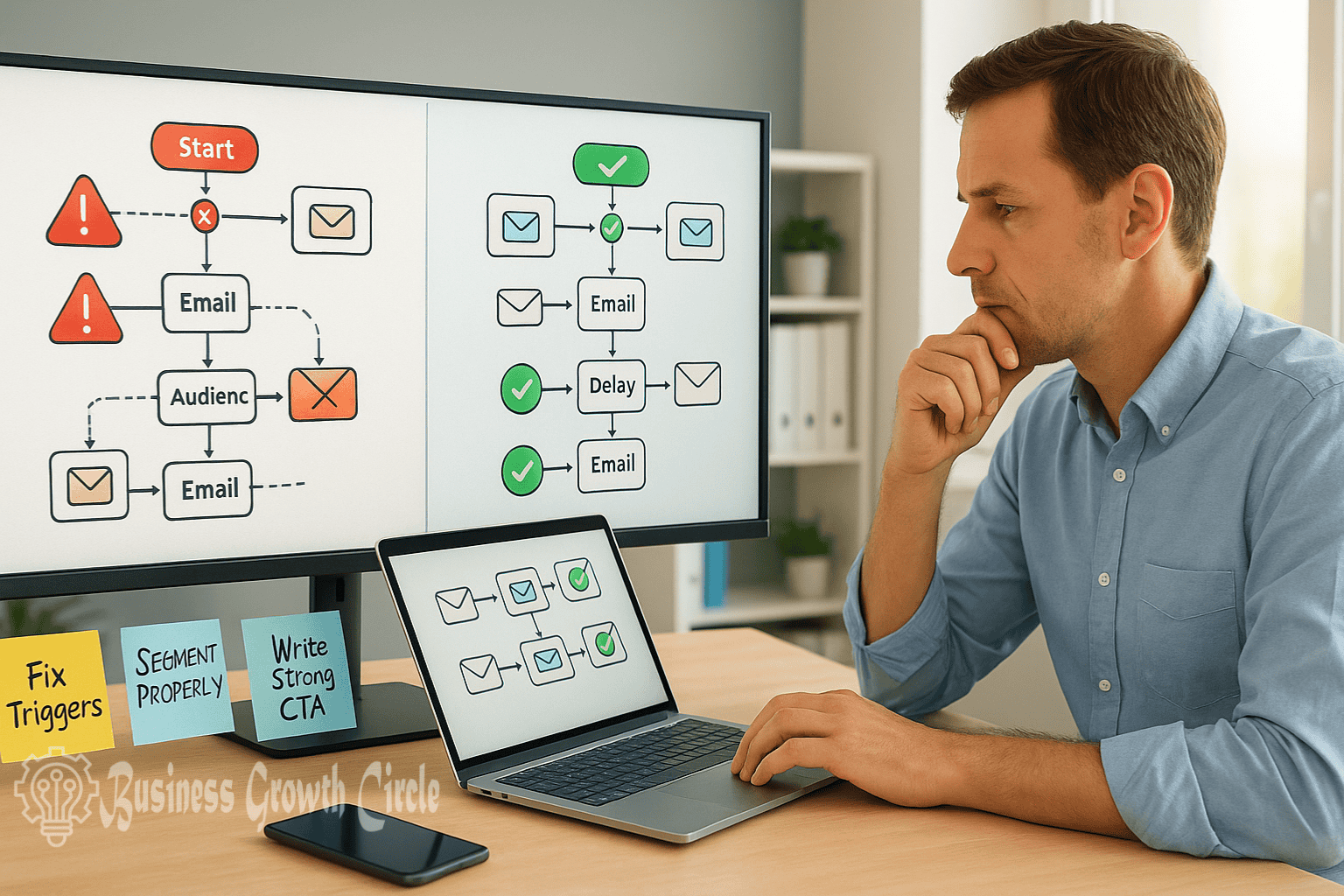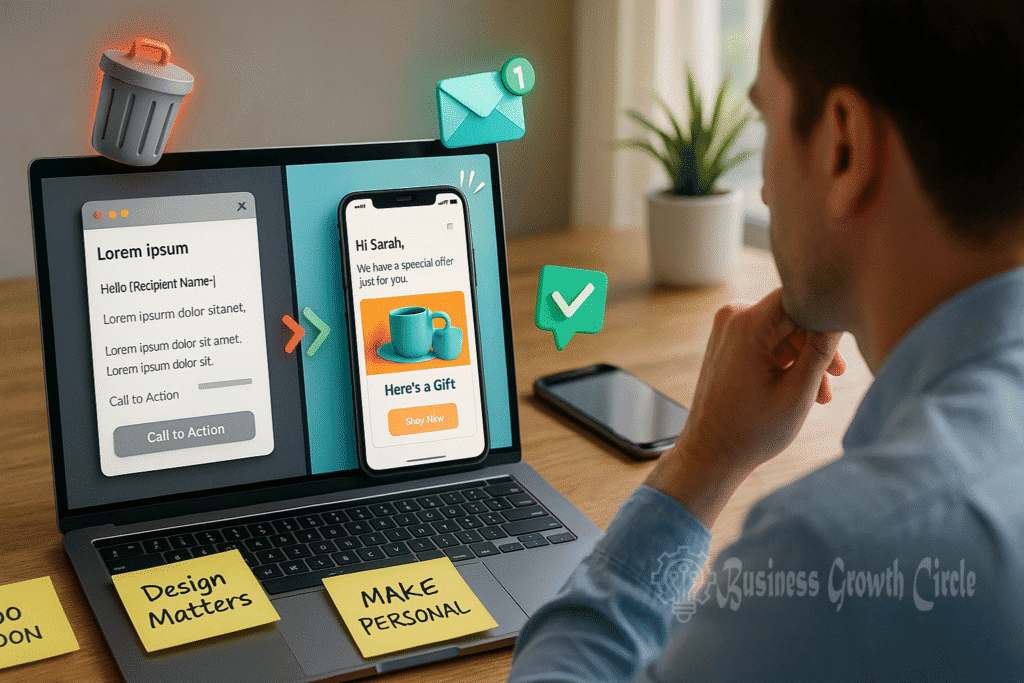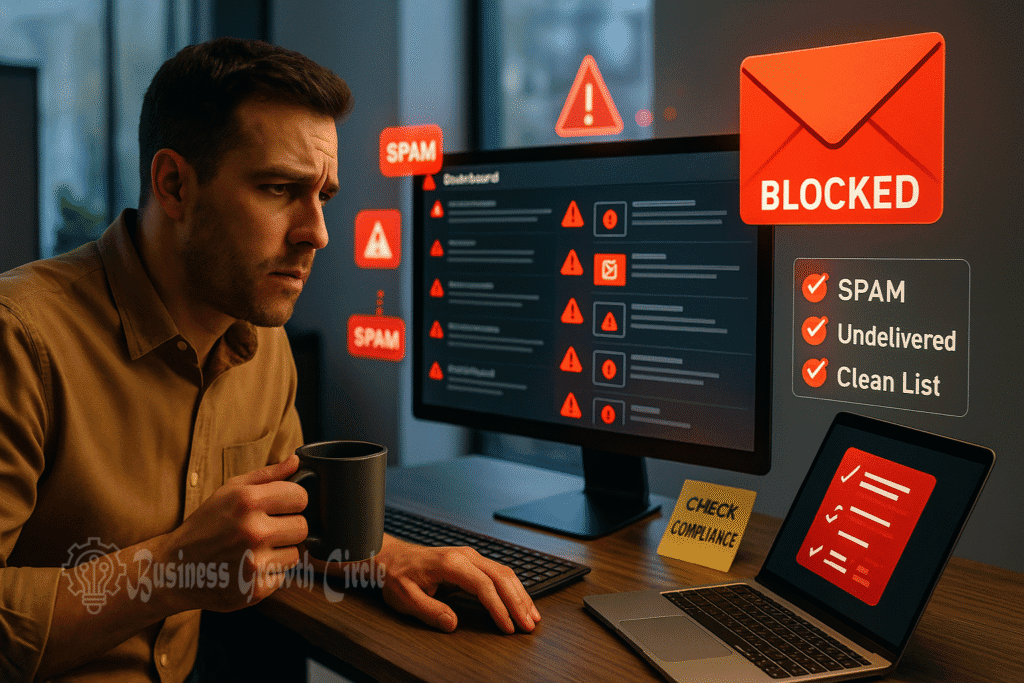
Automated Email Campaigns: Mistakes That Sabotage Your Success [2025 Update]
Ever feel like you’re pouring your heart and soul into automated email campaigns, but somehow the results just don’t add up? I’ve been there too, staring at a dashboard that doesn’t budge, wondering what went wrong. Automated email campaigns have become the heartbeat of digital marketing, giving you the chance to connect and build real trust with your audience at any hour, any day.
But that power comes with a hidden catch. It’s all too easy to fall into the same traps that trip up so many. One careless mistake, one overlooked detail, and the opportunity to turn a subscriber into a loyal customer slips through your fingers. You don’t want your messages lost, ignored or, worse, annoying the people who matter most.
Let’s be honest—it’s not about sending more emails or finding the fanciest template. It’s about understanding where others stumble, so you don’t have to. In the next few minutes, you’ll learn exactly which mistakes can quietly sabotage your success, and how you can break the cycle for good.
Neglecting Personalization and Segmentation
So you’ve put your heart into your automated email campaigns, but your numbers still look flat. You wonder if your list is getting tired or if your offer isn’t strong enough. But here’s something that changed everything for me: Most subscribers don’t respond because your message reads like it could go to anyone. When your emails sound like they’re for a crowd, people feel unseen. Nobody wants to feel invisible. It’s like being at a party where no one remembers your name.
Personalization and segmentation give your emails soul. The smallest touch—a name, a nod to a past purchase, a detail that matters—means the difference between “seen” and “ignored.” If you’re treating your list like a one-size-fits-all sweater, you could be warming up no one.
Sending One-Size-Fits-All Emails
You know those emails that greet you with “Dear Customer” or don’t reference anything you care about? Honestly, you probably skip past them just like I do. And there’s a good reason for that. People crave connection. If your automated email campaigns ignore personal details, you’re just another “unread” stat waiting to happen.
- Open rates drop when readers don’t feel spoken to.
- Conversion rates tank when your message lacks relevance.
- Brand loyalty? Forget it. You can’t build trust when you talk like a robot.
Think about it this way: Each subscriber is a real person with their own story. When your email could land in anyone’s inbox and sound the same, readers don’t feel special—they feel like a number.
You can stand out just by using their name, mentioning their last interaction, or reminding them why they signed up. These simple acts whisper, “I remember you.” That’s where the magic starts, and results grow.
Failing to Segment the Audience
Let’s call it what it is: Not all subscribers are alike. Treating everyone the same is like inviting your whole phone book to dinner—awkward, messy, and nobody gets what they want. Segmentation lets you talk to people about what matters to them.
Here are some best practices to stop sending emails into the void:
- Segment by past behavior. Did they buy last month, or just sign up? Tailor messages to fit where they are.
- Group by interests. Use tags for preferences—like kids’ clothes, tech gadgets, or outdoor gear—so every email hits home.
- Sort by engagement. Reach out differently to super-fans and those who haven’t opened an email in ages.
- Personalize offers. If someone always clicks on running shoes, show them more, not sandals.
Start simple. Even separating your audience into three groups—new, loyal, lapsed—can spark a shift.
If you dream about more replies, more sales, and more people feeling seen, segmentation is your best friend. Treat your subscribers as individuals and you’ll turn your automated email campaigns from “just another message” into something they actually look forward to. Remember how good it feels when someone remembers what matters to you? Give your audience that feeling, every time.
Overlooking Email Timing and Frequency
Let’s talk timing. Automated Email Campaigns can feel like setting clocks on ten different ovens—if you get it wrong, the cookies burn and nobody wants a taste. The reality? Even the most beautiful message falls flat if it lands in your subscriber’s inbox at the wrong moment, or if it keeps showing up until it’s impossible to ignore… or like, unsubscribe.
You might have seen this yourself: an email that shows up at 2 a.m., or a brand that pings you five times a week about socks when you only bought socks once. Before you know it, you’ve hit “unsubscribe,” and that’s one more relationship lost. The right timing and a gentle rhythm feel like a friend reaching out—not a salesperson camping in your inbox.
Here’s how to stop missing the mark and start making every send count.

Ignoring Optimal Send Times
There’s no single magic hour for everyone. Your people are unique, and the best send time isn’t set by industry averages—it’s set by your subscribers’ lives. If you send your email when your audience is busy, asleep, or just tuned out, your message gets buried. All your hard work? Invisible.
So, how do you find those “sweet spots” when people are ready to read and respond?
Let your data do the talking. Peek into your email platform and look for patterns:
- Open Rates: Check what days and times your emails are actually opened. Are mornings better? Late afternoons? Weekends?
- Time Zones: Your audience is spread out. Use time zone segmentation so emails don’t show up at 5 a.m. for half your list.
- A/B Testing: Try sending the same email at different times to small groups. Which group opened more? Stick with that winning time.
- Follow the activity: Did someone browse your website at lunchtime? Trigger automated emails when they’re active, not just when your calendar says so.
If you assume one schedule fits all, your automated email campaigns might end up ignored, or worse, pushing subscribers out the door. Take time to learn what works for your people—you’ll see higher open rates and much better engagement.
Bombarding Subscribers with Too Many Emails
Let’s be honest: nobody likes a pushy friend. If your “friendship” is all take and no give, it gets old fast. Automated Email Campaigns should feel like an open hand, not a non-stop knock. Bombarding subscribers turns trust into annoyance, and the unsubscribe button becomes way too tempting.
Here’s how you might lose people by sending too much:
- Unsubscribe rates spike: Too many emails and your best leads vanish without a word.
- Open rates drop: People start to ignore your emails, even if they once liked hearing from you.
- Spam complaints rise: Your reputation tanks. Internet providers might label your emails as spam and… you’re blocked.
So, how do you keep your audience excited instead of exhausted?
- Set clear expectations: Tell subscribers upfront how often you’ll be in touch. If you promise one email a week, don’t send five.
- Find your “just right” frequency: Use your analytics to see when people tune out. If opens dip after the third email in a week, scale back.
- Let them choose: Offer preferences—weekly digest or monthly highlights? Respect their wishes and honor what they pick.
- Mix it up: Value beats volume. If all you send are offers, people burn out. Balance promos with actual help, useful tips, or inspiring stories.
Remember: each email should be a welcome guest, not an uninvited visitor. When you respect your subscribers’ time and space, your automated email campaigns build trust, and people actually look forward to your next message. It’s about quality, not quantity—just like every great friendship.
Neglecting Email Content Quality and Design
You spend hours planning your Automated Email Campaigns, hoping each message lands with meaning. But all that work means nothing if your emails look lazy or just fall flat on a phone screen. You want every subscriber to feel your message was written just for them, with care and intention. The truth? People judge your emails fast. If the content feels generic or the design looks off, your message goes straight to the trash. Let’s break down where many go wrong — and how you can stand out.

Using Weak Subject Lines and Calls-to-Action
Para
Let’s start with the subject line: it’s the front door to your email. If it looks boring or smells like a sales pitch, nobody’s knocking. I used to go for clever puns or clickbait, thinking more would open. But when people feel tricked or confused, they check out for good.
Think about the last email you opened. What grabbed your attention? You probably clicked because the subject promised something real. Simple, honest, clear. That’s what wins. Good subject lines act like a handshake – firm, friendly, trustworthy.
How to write subject lines that connect:
- Keep it short: Aim for 6–10 words. Long lines get cut off or ignored.
- Be direct: Tell readers what’s inside. No tricks.
- Spark curiosity: Tease value, but don’t be vague. Give them a reason to look.
- Sound human: Write like you speak. “You left something behind?” works better than “Reminder: abandoned cart.”
If you get them to open, you’ve won half the battle. Now the call-to-action (CTA) has to show them what to do next. Weak CTAs sound like background noise – nobody acts. Strong CTAs feel like a clear invite from a friend.
Here’s what works:
- Use action words: “Get your free guide,” or “Start your trial today.”
- Make benefits obvious: “Save 10% now” tells readers exactly what they gain.
- Only one main CTA per email: Too many choices mean no choice at all.
If your subject line is a promise and your CTA is the open door, don’t leave people stuck in the hallway. Write with heart, speak their language, and show them the way.
Not Optimizing for Mobile Devices
Does your email look broken on a phone? You’re losing half your readers before you even start. Most people hold your Automated Email Campaigns in the palm of their hand. If your message looks tiny, cluttered, or makes them pinch and zoom, they swipe away.
I learned the hard way. I sent out a bold, beautiful email on desktop… and watched as open rates dropped and complaints rolled in from mobile users. There’s nothing worse than seeing your hard work turned into a jumble of broken images and unreadable text.
Here’s why mobile-first design matters:
- Roughly half of all emails are opened on phones.
- Readers decide in seconds if your message earns their attention.
- Poor design feels lazy or disrespectful — like showing up late to dinner.
How can you make your emails mobile-friendly? Here’s the cheat sheet I wish I had:
- Use a single column: Multi-column designs go sideways on small screens.
- Large, readable text: No squinting required. Aim for at least 14-16px fonts.
- Big, touchable buttons: Tiny CTAs get missed. Make them wide and finger-friendly.
- Compress images: Fast load times keep people engaged. Slow emails get closed.
- Test before sending: Use your own phone or an online preview tool. See what your subscribers see.
When you respect your reader’s screen, you respect their time. Powerful Automated Email Campaigns speak clearly on every device, every time. Give your subscribers a reason to read, click, and stick with you—wherever life finds them.
Failing to Monitor and Test Campaign Performance
No one gets everything perfect the first time. You can pour your heart into Automated Email Campaigns, but if you aren’t checking the numbers, you’re basically sending messages into a black hole. I’ve learned this the hard way: love alone doesn’t pay the bills, and hope isn’t a strategy.
To see real growth, you have to treat every campaign like a living, breathing thing. Watch it.
Feed it. See how it changes with every small tweak. When you skip this step, you’re stuck wondering why nothing works—like driving with your eyes closed and hoping for green lights.
That’s why tracking and testing are not just suggestions—they’re the heartbeat of all winning Automated Email Campaigns. Here’s how you can stop flying blind and start seeing real returns.
Ignoring Analytics and KPIs
Let’s get real: the numbers tell the story you can’t see with wishful thinking. If you ignore metrics, you miss all the small signs pointing you toward success—or warning you before a crash.
What should you watch? Don’t drown in data. Start with the numbers that truly matter:
- Open rate: Your subject lines shine or die here.
- Click-through rate (CTR): The only real measure of curiosity and action.
- Unsubscribe rate: If this spikes, you’re doing something wrong. Time to listen.
- Bounce rate: Check if you’re hitting ghost emails or real people.
- Conversion rate: This is it—the number of people who take the step you wanted.
These numbers act like footsteps in snow. They show you where your subscribers pause, where they run, and where they wander away. If you notice opens are low, your subject lines might be missing the mark. If clicks drop, maybe your content feels flat. When conversions slip, it’s time to rethink your offers or landing pages.
What do you do next? Don’t panic—adjust. Change one thing at a time so you know what’s working. Try a new send time, rewrite that subject, or sharpen your call-to-action. Then, check the numbers again. Wash, rinse, repeat.
Remember: Automated Email Campaigns reward those who listen and learn. Be the kind of marketer who trusts the story the data tells—even if it means going back to the drawing board.
Skipping A/B Testing
If you aren’t testing, you’re guessing. And nobody finds gold by guessing. Sometimes, the smallest change turns an email from invisible to unforgettable.
Here’s the secret—your opinion on what “works” doesn’t matter. The only voice that counts is your subscriber’s. A/B testing (also called split testing) gives your audience a say in what they want. You send two versions to small groups. They pick the winner for you.
Want to know where to start? Test what matters most:
- Subject lines: Do friendly questions or bold statements get more opens?
- Content: Short and sweet, or longer stories? Images or clean text?
- Send times: Early birds or night owls? Which gets more love?
- Calls-to-action: “Buy now” or “Learn more?” One button or two?
You’ll be surprised how much difference one word can make. I once changed a subject line from “Don’t Miss Out” to “A Gift for You” and watched my open rate double—no exaggeration.
Tips for meaningful A/B tests:
- Test one thing at a time. If you change everything, you’ll never know what worked.
- Give each version enough time and subscribers. Don’t stop after two hours.
- Use the winner for your next big send. Celebrate your tiny victory—one small experiment at a time.
Automated Email Campaigns are built on learning what lights people up. When you test, you learn. When you skip it, you’re stuck in the dark.
Success comes to those who pay attention, and who aren’t afraid to try, change, and try again. The next subject line, color, or send time could be the one that finally gets your message heard.
Overlooking Compliance and Deliverability Issues
Let’s get real for a moment. Automated Email Campaigns are a shortcut to your audience’s trust… or a fast track to lost opportunities if you miss the details that count. If you ignore the rules or send messages that never arrive, your hard work can go to waste.
Picture it—pouring your time and creativity into emails, only for them to end up in spam folders or, even worse, stacking up legal trouble. No one wants that. Protecting your reputation starts with knowing the rules and keeping your list squeaky clean. Here’s how to avoid the biggest potholes.

Not Following CAN-SPAM and GDPR Guidelines
This is where doing the right thing isn’t just about being a “good” marketer—it’s about survival. Your Automated Email Campaigns must follow the law, or you’ll pay with penalties, angry subscribers, and a bruised reputation that’s hard to fix.
Remember the big headlines about millions in fines? You can avoid becoming the next cautionary tale by sticking to a few non-negotiables:
- Always include a clear unsubscribe link. No tricks, no hiding. Make it easy for people to opt out if they want to.
- Use honest subject lines and sender names. If your email says it’s from “Sandy at Cat Rescue,” Sandy better exist and be part of your team.
- Never buy email lists. Consent matters. Contact only those who gave you permission. In Europe and beyond, GDPR brings a sledgehammer to uninvited emails.
- Honor privacy requests. If someone asks to be deleted or to know what data you have, respond quickly and respectfully.
- Keep a record of consent. With GDPR, you need to prove people agreed to hear from you. Store those signups like gold—they are.
If you slip, the financial hit hurts—so does your relationship with your list. People want to trust you. Following the rules means you value their trust and their privacy. That’s not just smart; it’s the only way to build a loyal following in today’s world.
Neglecting Email List Hygiene
Here’s something most people ignore until it’s too late: your email list isn’t a trophy to dust off, it’s a living thing. If you don’t take care of it, it rots. Sending Automated Email Campaigns to an old or messy list feels like inviting strangers and ghosts to your biggest party—they fill the room, but do nothing.
List hygiene isn’t glamorous, but it’s your secret weapon. Cleaning your list boosts your sender reputation and keeps your deliverability strong. It’s like tending a garden: remove the weeds, and what’s left thrives.
So, what does good list cleaning look like?
- Regularly remove inactive subscribers. If someone hasn’t opened in six months, let them go. Dead weight drags down your stats.
- Watch for bounces. Emails that bounce back should be deleted—too many make email providers suspicious.
- Spot the spam traps. Old, abandoned email addresses can hurt you. Use tools that flag them before they cause problems.
- Check for typos and bogus addresses. You’d be surprised how many sign up as “test@test.com” or with a jumble of letters.
- Let people update their preferences. Maybe they want fewer emails or only certain topics. Give them control.
Cleaning your list doesn’t mean you’re giving up on people. It means you’re choosing to speak to the people who care, who want to hear from you, who might actually reply and take action. Open rates jump. Deliverability improves. And you build a stronger connection every time you hit send.
Don’t let all your energy go unseen. Treat your list with the respect it deserves, and your Automated Email Campaigns will reward you with loyal readers who listen and act. Isn’t that what we’re all after?
So what’s Next?
You don’t have to get everything right the first time, but you can side-step the mistakes that keep so many marketers stuck and frustrated. The simplest truths are often the most powerful: talk to people, not lists. Give your Automated Email Campaigns a heart by honoring your audience’s time, caring about their privacy, and delivering emails that feel personal—even when no person is hitting send.
Stay curious. Study your data, clean your list, and keep your finger on the pulse of what your subscribers care about most. Let every mistake be a lesson, not a roadblock. Trust that when you respect your audience, your results will catch up.
If you’re ready to turn your emails from background noise into something unforgettable, start now. Listen closer. Test bravely. Give every message a reason to be opened. Then watch what happens.
A good read: 40Common email marketing mistakes to avoid
Thank you for pouring your time and energy into learning something new today. Your audience—and your future self—will thank you for every step you take. What one change will you make next? I’d love to hear your story.
